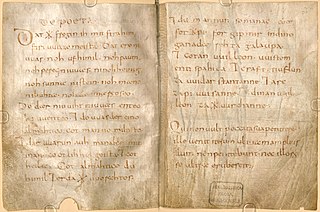Wessobrunn Prayer

The Wessobrunn Prayer (German: Wessobrunner Gebet, also Wessobrunner Schöpfungsgedicht, "Wessobrunn Creation Poem") is among the earliest known poetic works in Old High German, believed to date from the end of the 8th century.
Provenance and reception[]
The poem is named after Wessobrunn Abbey, a Benedictine monastery in Bavaria, where the sole manuscript containing the text was formerly kept. The abbey was dissolved in 1803 and its library incorporated into the Bavarian Royal Library in Munich, under the signature Clm 22053. The script of the Latin title is uncial, that of the text Caroline minuscule. Paleographic characteristics of the script support production in Bavaria, with some Swabian influence, consistent with an origin in southern Bavaria, likely in the Diocese of Augsburg. The manuscript was probably not written at Wessobrunn, however (original monastery at Wessobrunn was destroyed in a Magyar raid in 955). Suggestions for the origin of the manuscript include Regensburg, Benediktbeuern, Staffelsee and Augsburg itself.[2]
The manuscript is a convolution of five parts, with a total of 98 folia (numbered to 99, fol. 8 missing). The poem is contained at the end of the second fascicle (foll. 22-66), on foll. 65v/66r, following a collection of Latin excerpts on theology, geography and metrology.[3] The date of composition is put in the reign of Charlemagne, roughly in the 790s (estimates range from "shortly after 772" to "shortly after 800").[4] The manuscript itself was written in the early 800s, most likely the years just predating 814.[5]
The language has some Bavarian characteristics (cootlîh, paum, pereg) besides traces of Low German or Anglo-Saxon influence, specifically in the first line (dat is Low German; gafregin ih parallels OS gifragn ik and AS ȝefraeȝn ic).[6] Anglo-Saxon influence is further suggested the scribe's representation of the word enti "and" (with one exception) by Tironian et (⁊), and by the use of a "star-rune"
